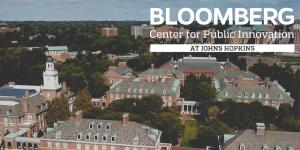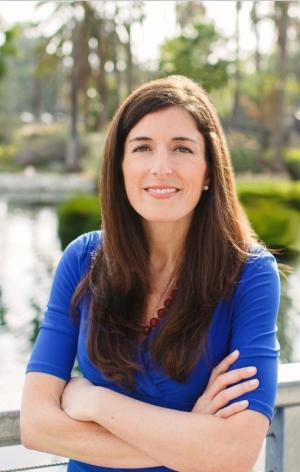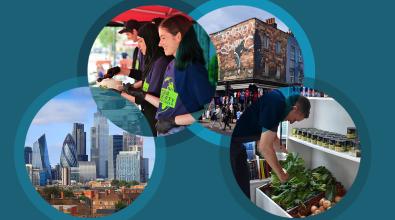Creating a resource for city workers to transform government

Just last week, Bloomberg Philanthropies announced the launch of the new Bloomberg Center for Public Innovation at Johns Hopkins University. Created by a $43 million investment, the Center will help cities deliver better results for residents and advance the field of public-sector innovation. Already, the Center has launched a call for applications for Innovation Training and launched Love Your Block grant program support in eight cities in the U.S.
“City leaders have unique powers to save and improve lives, and this new Center will help them do more of both, by advancing the art and science of innovative local government,” said Michael R. Bloomberg, 108th mayor of NYC and founder of Bloomberg LP and Bloomberg Philanthropies. “The Center will be the first of its kind in the world, and it will help meet the enormous demand we have heard from mayors and their staffs for bold and creative new ways to tackle their most pressing challenges.”
Amanda Daflos, the Executive Director of the new Center, has dedicated her career to innovation in the public sector, serving as the Chief Innovation Officer for Los Angeles and directing the Los Angeles Innovation Team.
Here, she shares some of her thoughts on the future of public-sector innovation and why it’s important to support local leaders who drive it—often behind the scenes.
Why is the new Bloomberg Center for Public Innovation so important?
The public-sector workforce is full of gamechangers making a difference on limited budgets, short timelines, or without the bandwidth to do the kind of data analysis we know drive the best results for residents. I’ve worked and lived that challenge and am excited that we’re creating the resource that I wish I had when I was serving on the front lines.
We’re structuring the Center as a place to learn and share ideas that produce better outcomes for residents, a network of public leaders using cutting-edge methods and powering the latest research that will help them better serve their communities, build trust, and save money.
From mayors to staffers, whether you’re starting up a new program or changing a complex process or policy that has been around for a long time, our support is designed to make the hard work of change management easier. Public-sector leaders need networks of support to do their best work and they need effective tools that are based on research and evidence that have been tested in the real world.
Our government innovation approach—using data to guide decision and policy making, applying human-centered design, and incorporating community-based work—is designed to be, and has proven to be, that answer for local leaders.
In my own career, I’ve seen the results of what innovation thinking can create firsthand. When I led the Innovation Team in Los Angeles, we leveraged tools like those now offered by the Center to create serious impact on a housing shortage, bring gender equity programs to life, transform the way the Los Angeles Police Department recruits new police officers, and champion a long list of policy and process changes that helped residents and city teams understand that there is a lot of power to change the way local government thinks about and does business.
Now, at the Center, we have an opportunity to teach that approach to local government executives and city staff and ensure that good methods and ideas spread. We’re going to make government innovation an authoritative practice in the public sector and elevate all of the ways it helps build healthy communities.
Tell us about yourself. What path brought you to this new role?
I have always been equally invested in public service and problem solving. I also believe that government has a responsibility to support residents in pursuing their best lives.
My belief is rooted in my personal experience with government and the services my family received at times when we needed them the most and the people we encountered along the way. Some were heroes and made incredible things possible. With that in mind, I intentionally pursued a career in government transformation with the idea that we can’t rely only on heroes. We must rely on equitable, repeatable, and resilient systems and policies that enable all public-sector staff to do their work flawlessly and with pride. When I began my career more than 20 years ago, government innovation or transformation was not a defined field of work, but I was fortunate enough to secure skill-building roles early on that ultimately put me in the middle of some of America’s toughest public policy and national moments.
Early on, my experience came from nonprofit work—for small and large organizations based in the U.S. and internationally. I worked at JDRF, which funds type 1 diabetes research, and later in the mountain regions of Nepal. After receiving my Master of Public Administration at the University of Colorado, I joined Deloitte Consulting’s public-sector practice where I worked with federal, state, and local government organizations on a variety of efforts from reforming aspects of state and local child welfare agencies, to standing up the health benefits exchange with a team in Washington State, to supporting federal agencies with major military processes. This was great preparation for what would come next.
In 2015, when I was appointed by Mayor Eric Garcetti to start Los Angeles’ innovation team, there was no way for us to know how important this work would become. We grew the team from a small office space with no windows, to the first modernized office space in City Hall, to me eventually serving as the first Chief Innovation Officer and taking on some of the biggest challenges the city faced.
We did some truly impactful work in partnership with our mayor and other remarkably dedicated civil servants. We developed the gender equity agenda for Los Angeles, which has been replicated in other global cities, and launched paid parental leave for city employees. I oversaw a lot of the pandemic work for the city as the data, research, and science lead. I’m proud to say we drove programs that changed the lives of many for the better in ways we could see, experience, and count.
We saw more than a 1000-percent increase in permits being requested to build accessory dwelling units in just the first year of our work. We saw more than 300 parents benefit from paid parental leave—mothers, fathers, adoptive parents—in just the first six months of this life-changing, budget-neutral program it took us two years to launch. We significantly increased the diversity in the Los Angeles Police Department—already one of the most diverse police agencies in America—and modernized the recruitment tools in use for reaching diverse candidates of all backgrounds.
Facing that new role and the very real challenges in partnership with other global leaders was great preparation for the work I’m doing now launching for the Bloomberg Center for Public Innovation.
What is your vision for the Center?
I’m growing a team focused on changing the culture in public-sector work through government innovation. I want to see a world where excellence and the best service are synonymous with government and advanced by leaders, community members, and residents together. I want to see a world where residents understand that much of what happens in their everyday life—the lights, water, tree trimming, trash pick-up, the safety and cleanliness of their favorite restaurant—are a result of local government. Government must serve its residents effectively, efficiently, and equitably, and residents must participate in the process to ensure the changes they want to see are reflected in the structures and services of government. I want to see a world where public service is the career people turn to for their first job and stay for a lifetime because they have the tools they need to make challenging decisions and do the hard work of improving communities.
The Center will be the place where global public leaders and teams can come when they need support, when they need tools, when they need training, or when they need a place where they can partner to develop great ideas. We will offer grant programs to jumpstart bold ideas. We will offer student and faculty programming as well as fellowship opportunities for leading government executives.
The Center will also be a place where we blend research with applied knowledge and cutting-edge government practice. At Johns Hopkins, we have a world-class research institution to draw from and we’ll have staff, like me, who have done the work on the ground in city, state, and federal government. We’ll offer public leaders the best of both research and practical skills.
Ultimately, our work will increase the skill base and capacity of government, through both formal training and our work on the ground. We’ll be developing curriculum and offering classes, as well as administering programs with technical assistance from experienced staff to put that knowledge into practice. We want to build up the next generation of public-sector leaders and equip them with the tools and skills to produce the best outcomes for residents.
What programs will be part of the new Center?
Bloomberg Philanthropies has spent 10 years advancing innovation in local government. They formalized the field in an unprecedented way that was long overdue. The Center will serve as the permanent home for several of their flagship government innovation programs. We’ll grow those initiatives, launch new programs, and bring together new collaborations to help leaders and residents.
There are five main practice areas at the Center. The first is innovation, which includes, among other work, Innovation Teams or i-teams, which are already at work in almost 50 cities and eight countries around the world.
The second area is digital, which encompasses Digital Innovation Teams, Digital Service Transformation, and more.
Then there’s civic engagement, including Cities of Service, which helps mayors engage and solve problems with residents through programs like Love Your Block.
The fourth area is academics. Bloomberg Philanthropies is establishing three new Bloomberg Distinguished Professors, whose research in urban policy and government innovation will be invaluable to city leaders. We will also have student engagement here at Johns Hopkins and a new fellowships to provide government executives from around the world with the opportunity to reflect and develop ideas that help advance the field.
And, finally, we’ll provide communications tools and resources, which are so important for delivering results and working effectively with residents. There will be much more detail to come, but I’m excited to share that we are off to fast start bringing these existing and new initiatives to life and already seeing impact on the ground.
We’re structuring the Center as a place to learn and share ideas that produce better outcomes for residents, a network of public leaders using cutting-edge methods and powering the latest research that will help them better serve their communities, build trust, and save money.
Why is now the right time to launch the Bloomberg Center for Public Innovation?
The American Rescue Plan has left many cities with an abundance of funds. We know that dumping money on a problem won’t fix any serious social issue—it rarely has. This is a rare opportunity for cities of every size to implement solutions that create lasting change and focus on excellent ideas and expert delivery. We don’t want to look around in a few years and wonder what happened to all the money or look back in decades to realize the best opportunities and ideas for change were available and just unshared. The Center can help cities plan using the latest data and research, help them staff correctly, and expertly deliver effective programming so that we don’t squander this moment.
It’s more than ARPA, of course. Bloomberg has made this investment at a time when the world faces several crises—the ongoing pandemic, climate change, steep inequality—to name a few. Cities have an important role in addressing those challenges and we will help them do that in ways that outlast most of us in our current roles and drive impact for generations.
In addition, we are living at a time when story and voice are more important than ever. Old ideas, like the notion that cities are stuck or not working for residents, can become major hurdles for progress if we don’t reset them with the truth. The truth is cities are innovating the structures of government every single day. The Center aims to shine the light on that truth, innovation leaders, and the growing mountain of evidence that shows the amazing ways cities are serving residents to inspire more innovation and investment in public-sector work.
How will city leaders and residents benefit from the Center?
At the end of the day, all of our work is about how we help cities produce exceptional results for residents. That will show up on the ground through grant programs like Love Your Block and in influencing and advancing thought leadership on what cities need by drawing from the research environment at Johns Hopkins and vast experience at Bloomberg Philanthropies.
It’s going to be an incredible opportunity to serve government leaders at a moment when they need partners most. We’re looking frward to helping them solve the problems they face and elevating the fact that there is innovation happening in governments everywhere and the future of public innovation—and the next generation of leaders—is being created right now.



